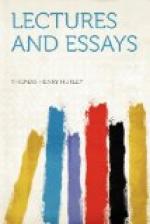In the course of the historical development of any branch of science, what is universally observed is this: that the men who make epochs, and are the real architects of the fabric of exact knowledge, are those who introduce fruitful ideas or methods. As a rule, the man who does this pushes his idea, or his method, too far; or, if he does not, his school is sure to do so; and those who follow have to reduce his work to its proper value, and assign it its place in the whole. Not unfrequently, they, in their turn, overdo the critical process, and, in trying to eliminate error, throw away truth.
Thus, as I said, Linnaeus, Buffon, Cuvier, Lamarck, really “set forth the results” of a developing science, although they often heartily contradict one another. Notwithstanding this circumstance, modern classificatory method and nomenclature have largely grown out of the work of Linnaeus: the modern conception of biology, as a science, and of its relation to climatology, geography, and geology, are, as largely, rooted in the results of the labours of Buffon; comparative anatomy and palaeontology owe a vast debt to Cuvier’s results; while invertebrate zoology and the revival of the idea of evolution are intimately dependent on the results of the work of Lamarck. In other words, the main results of biology up to the early years of this century are to be found in, or spring out of, the works of these men.
So, if I mistake not, Strauss, if he did not originate the idea of taking the mythopoeic faculty into account in the development of the Gospel narratives, and though he may have exaggerated the influence of that faculty, obliged scientific theology, hereafter, to take that element into serious consideration; so Baur, in giving prominence to the cardinal fact of the divergence of the Nazarene and Pauline tendencies in the primitive Church; so Reuss, in setting a marvellous example of the cool and dispassionate application of the principles of scientific criticism over the whole field of Scripture; so Volkmar, in his clear and forcible statement of the Nazarene limitations of Jesus, contributed results of permanent value in scientific theology. I took these names as they occurred to me. Undoubtedly, I might have advantageously added to them; perhaps, I might have made a better selection. But it really is absurd to try to make out that I did not know that these writers widely disagree; and I believe that no scientific theologian will deny that, in principle, what I have said is perfectly correct. Ecclesiastical advocates, of course, cannot be expected to take this view of the matter. To them, these mere seekers after truth, in so far as their results are unfavourable to the creed the clerics have to support, are more or less “infidels,” or favourers of “infidelity”; and the only thing they care to see, or probably can see, is the fact that, in a great many matters, the truth-seekers differ from one another, and therefore can easily be exhibited to the public, as if they did




